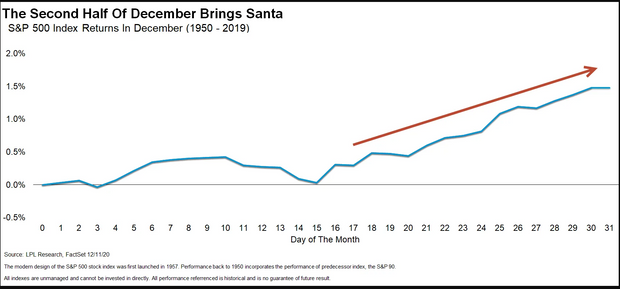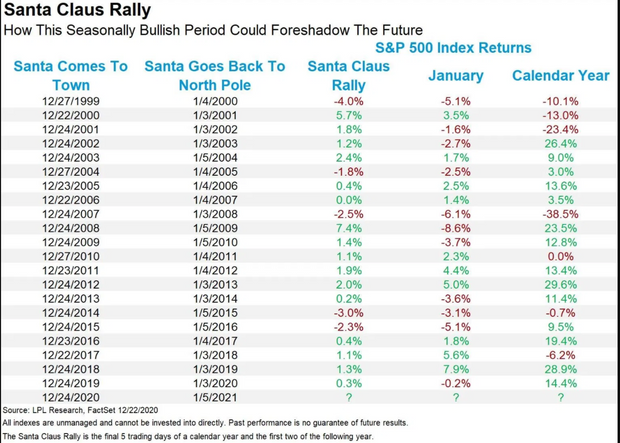Santa Claus may not be coming to town due to the pandemic, but he will pay a socially distant visit to Wall Street equity traders if history is any guide.
Stocks have performed exceedingly well during a seasonal period that includes the year’s last five trading days and the first two sessions of the new year, in what’s come to be known as the “Santa Claus” rally.
That period, which starts on Thursday this year, is considered one of the best seven-day stretches for equities in any point in a year, boasting an average return of 1.3%, the second-best performance among any seven-day period in a year. The span has also finished positive in nearly 78% of some 250 trading sessions, according to Ryan Detrick, chief market strategist for LPL Financial, in a Wednesday research note (table below).

Detrick says that it isn’t exactly clear why this December stretch proves historically to be such a good period on average, but some speculate that institutions squaring up their books at year-end, holiday consumer spending boosting corporate sales, thin trading volumes with many investors on vacation, and optimism over a coming year could all be factors in the bullishness that spreads across financial markets.
“The bottom line is that bulls tend to believe in Santa,” he writes.
It may be hard to have faith that stocks will muster a second leg of gains after a huge rebound from the lows seen in March when the coronavirus pandemic hit and another rally to this point in December.
The Dow Jones Industrial Average DJIA, +0.38% is already up about 2% so far on the month, the S&P 500 index SPX, +0.07% has risen 2.4% over the period and the Nasdaq Composite Index COMP, -0.29% has surged 5.2% thus far in December.
Detrick said there is reason to believe there is another leg to the rally because Decembers tend to get off to a relatively slow start and gain steam into the end of the calendar year.

Investors are worried about the market’s ability to sustain its nearly unabated rise to records and lofty valuations amid a resurgence of the COVID-19 pandemic in parts of the world and signs that new strains of the virus are cropping up, even as vaccines are being rolled out by the likes of Pfizer PFE, +1.91% and partner BioNTech BNTX, -0.50% 22UA, -1.78% and Moderna MRNA, +3.54%.
Earlier this month Yardeni Research’s Ed Yardeni said that he anticipated a strong December performance fostered by investors and fund managers rotating out of some of their winners of the pandemic period and into value-oriented stocks that have yet to enjoy the fruits of an improving economy.
Gains in December also follow a powerful rally in November, which MarketWatch’s William Watts said was unlikely to “steal” from December gains.
Detrick said that the effect of the Santa Claus rally can shape trade in the following year.
The analyst said that, going back to the mid-1990s, “there have been only six times Santa failed to show in December,” and in those instances January also brought a move lower five times, and the full year had a solid gain only once — in 2016, but a mini–bear market early in that year.
“Considering the bear markets of 2000 and 2008 both took place after one of the rare instances that Santa failed to show makes believers out of us. Should this seasonally strong period miss the mark, it could be a warning sign,” Detrick wrote.

That said, MarketWatch’s Mark Hulbert makes the case that a failed Santa Claus rally doesn’t always presage weak performance, though market researcher Yale Hirsch, creator of the Stock Trader’s Almanac, has observed: “If Santa should fail to call, bears may come to Broad and Wall,” referencing the intersection between Wall Street and Broad Street, where the New York Stock Exchange is located.
Analyzing the correlation between the Dow’s performance in the second half of December and its return for the subsequent year and made an interest finding: The stock market on average does better following late-December losses and no worse.
Hulbert cautions readers against extrapolating too much from his findings and notes that 2021 may stand apart from other years and seasonal trends given the global pandemic and its impact on economies.




